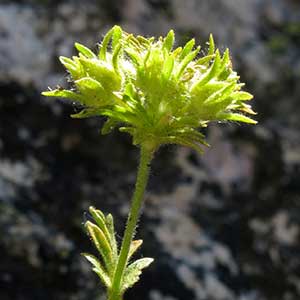Ivesia longibracteata
Ivesia webberi
Castle Crags ivesia, longbract mousetail
Webber's ivesia, wire ivesia, wire mousetail
ascending to erect, 0.3–1.2 dm.
decumbent to ascending, 0.5–1.5(–1.8) dm.
weakly planar to loosely ± cylindric, (0.5–)2–4(–6) cm; sheathing base glandular abaxially, otherwise glabrous;
petiole 0.5–2 cm, hairs 0.2–1 mm;
leaflets 5–6 per side, 2–6 mm, ± short-hirsute, glandular-puberulent, lobes 2–7, oblanceolate to spatulate or obovate, apex not setose.
loosely ± cylindric, 3–7(–10) cm; sheathing base ± strigose abaxially;
petiole 0.5–5(–6) cm, hairs 2–4 mm;
leaflets 4–8(–10) per side, (0.5–)3–8(–10) mm, loosely long-strigose or -villous and short-hirsute, ± glandular, lobes 2–5(–12), linear to lanceolate, apex not setose.
1–3, not paired.
2, paired.
3–14-flowered, 1–2.5 cm diam.;
glomerules 1.
5–15(–25)-flowered, 1.5–3(–6) cm diam.;
glomerules 1.
1.5–6 mm.
(0.5–)1–8(–13) mm.
8–10 mm diam.;
epicalyx bractlets linear to narrowly lanceolate or elliptic, 2.5–5 mm, longer than sepals;
hypanthium shallowly cupulate, 0.5–1 × 2–3 mm;
sepals 1.5–2.5 mm, ± acute;
petals pale yellow, linear to narrowly oblanceolate, 1.5–2.5 mm;
stamens 5, filaments 0.7–1.3 mm, anthers yellow, 0.5–0.8 mm;
carpels 6–11, styles 1–1.5 mm.
9–12 mm diam.;
epicalyx bractlets linear, 1.2–3 mm;
hypanthium cupulate, 1–2(–2.5) × 2.5–5 mm;
sepals 2.5–4.5(–5.5) mm, acute;
petals yellow, narrowly oblanceolate, 2–3(–4) mm;
stamens 5, filaments 1.8–2.5(–3) mm, anthers yellow, (0.8–)1–1.6 mm;
carpels 3–8, styles 1.8–2.2 mm.
cream to light tan, 1.2–1.5 mm.
light brown, often mottled darker brown, 1.9–2.5 mm.
Ivesia longibracteata
Ivesia webberi
Of conservation concern.
Ivesia longibracteata is known only from the Castle Crags area of Shasta County. The epithet alludes to a diagnostic characteristic unique in the genus: the epicalyx bractlets are longer than the sepals. The plants grow on vertical rock faces, a habitat more characteristic of sect. Setosae; however, the stems are ascending to erect and do not form hanging clumps, and the pedicels are not curved in fruit.
(Discussion copyrighted by Flora of North America; reprinted with permission.)
Of conservation concern.
Ivesia webberi is known only from the eastern foothills of the northern Sierra Nevada and scattered ranges to the east in California and adjacent Nevada. It is among the more distinctive species in the genus and is only tentatively placed in sect. Ivesia. The leaflets are loosely incised into slender, sparsely villous segments, and the two cauline leaves are paired with dissected stipules. Previous reports of the stems and inflorescence branches being glandular-puberulent are due to a misinterpretation of the minute pustulose bases associated with the villous indumentum as being enlarged glands.
(Discussion copyrighted by Flora of North America; reprinted with permission.)


